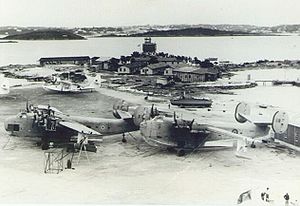- RAF Ferry Command
-
Royal Air Force Ferry Command Active 20 July 1941–25 March 1943 Country  United Kingdom
United KingdomBranch  Royal Air Force
Royal Air ForceType Command Role controlling Transport aircraft Engagements World War II The RAF Ferry Command had a short life, but it spawned, in part, an organisation that lasted well beyond the war years during which it was formed.
Contents
History
 RAF Darrell's Island during WWII. This base was used throughout the war for trans-Atlantic ferrying of aircraft (like the Catalinas to the rear of photo. Transport flights (such as those flown by the Coronados in the foreground) moved, in 1943, to the British section of the airfield built by the US Army Air Forces, Kindley Field.
RAF Darrell's Island during WWII. This base was used throughout the war for trans-Atlantic ferrying of aircraft (like the Catalinas to the rear of photo. Transport flights (such as those flown by the Coronados in the foreground) moved, in 1943, to the British section of the airfield built by the US Army Air Forces, Kindley Field.
The practice of ferrying aircraft from US manufacturers to the UK was begun by the Atlantic Ferry Organization ("Atfero") set up by Morris W. Wilson, a banker in Montreal. Wilson hired civilian pilots to fly the aircraft to the UK. The pilots were then ferried back. 'Atfero hired the pilots, planned the routes, selected the airports [and] set up weather and radiocommunication stations.'[1]
Ferry Command was formed on 20 July 1941, by the raising of the RAF Atlantic Ferry Service to Command status.[2] Its commander for its whole existence was Air Chief Marshal Sir Frederick Bowhill.[2] He was also the first commander of Ferry Command's successor, Transport Command.[2]
As its name suggests, the main function of Ferry Command was the ferrying of new aircraft from factory to operational unit.[3] Ferry Command did this over only one area of the world, rather than the more general routes that Transport Command later developed. The Command's operational area was the north Atlantic, and its responsibility was to bring the larger aircraft that had the range to do the trip over the ocean from American and Canadian factories to the RAF home Commands.[3]
This was pioneering work: before Ferry Command, only about a hundred aircraft had attempted a North Atlantic crossing in good weather, and only about half had made it. Over the course of the war, more than 9,000 aircraft were ferried across the ocean and, by the end of the war, crossing the Atlantic had become a routine operation, presaging the inauguration of scheduled commercial air transport services after the war.[4]
Ferry Command was subsumed into the new Transport Command on 25 March 1943 by being reduced to Group status as No. 45 Group.[2] No. 45 Group still retained responsibility for Atlantic aircraft ferrying operations, but Transport Command was a worldwide formation, rather than a single-mission command.
Aircraft were first transported to Dorval Airport near Montreal, and then flown to Gander Airport in Newfoundland for the trans-Atlantic flight.[4]
References
Notes
- ^ World War In the Air: One Way Airline, Time magazine, 20 October 1941. See also Jeffrey Davis, 'ATFERO: The Atlantic Ferry Organization,' Journal of Contemporary History, Vol. 20, No. 1, January 1985
- ^ a b c d Air of Authority - A History of RAF Organisation - RAF Home Commands formed between 1939 - 1957
- ^ a b Flying the Secret Sky: The Story of the RAF Ferry Command
- ^ a b Ferrying Aircraft Overseas - Juno Beach Centre
Bibliography
- Christie, Carl A. and Hatch, F. J., Ocean Bridge: The History of RAF Ferry Command, Toronto, University of Toronto Press, c1995. ISBN 9780802081315
- Delve, Ken. The Source Book of the RAF. Shrewsbury, Shropshire, UK: Airlife Publishing Ltd., 1994. ISBN 0-85310-451-5.
- Atlantic Ferry Flight December 1941
Formations and units Commands · Groups · Stations · Wings · Aircraft squadrons · Aircraft flights · Conversion units · Regiment squadrons

Branches and components RAF Regiment · RAF Chaplains Branch · RAF Intelligence · RAF Legal Branch · Princess Mary's RAF Nursing Service · RAF Police · Search and Rescue Force · Mountain Rescue Service
Reserve forces Associated civil organizations Air Training Corps · RAF Association · RAF Centre of Aviation Medicine
Equipment List of RAF aircraft · List of RAF missiles
Personnel Symbols and uniform Categories:- Royal Air Force commands
- Military units and formations established in 1941
Wikimedia Foundation. 2010.
